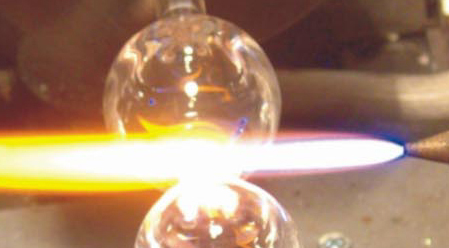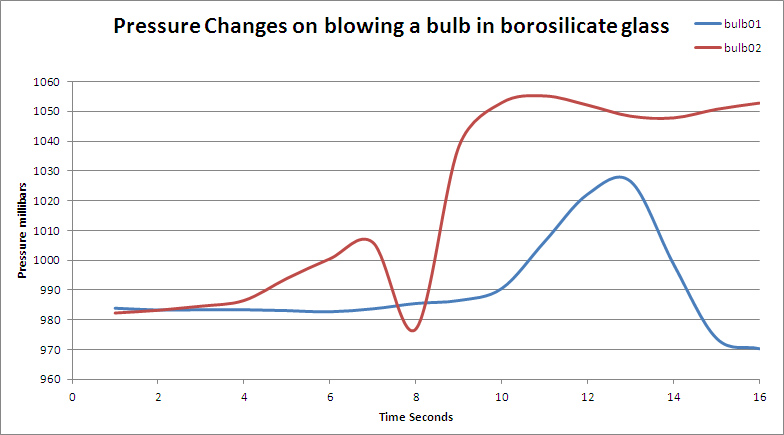
ALL MATERIAL COPYRIGHT KEVIN SCOTT 2011. LINKS TO THIS SITE ARE WELCOME BUT DO NOT COPY MATERIAL FROM THIS SITE TO ANY OTHER WEBPAGE.
If you find this site useful, please support it by making a donation of $1 to help maintain and develop it. Click on the PAYPAL DONATE button to do this safely. But there is no obligation - please avail yourself of the information and facilities of the site at no charge.
This brief study forms a very small part of a wider project to develop computer controlled machines for automatic glass blowing. Some automation is commercially available for simple glassblowing processes, but generally, glassblowing requires control over a very large number of degrees of freedom and feedback from many sensory sources that serious automation of the art is both highly complex and prohibitively expensive. The simple task of blowing a small bulb at the end of a glass tube requires the glassblower to exercise control over actions many times more numerous than, say a 4 or 5 axis CNC machine. The following table is by no means an exhaustive list, but gives some idea of the multi-dimensional scope of a glassblower's skill
| Operations required of a Glassblower in blowing a small bulb |
| Left Hand x-y-z translational control |
| Right Hand x-y-z translational control |
| Left hand manual pressure control and rotational action between thumb and first finger |
| Right hand manual pressure control and rotational action between thumb and first finger |
| Visual observation of temperature and glass fluidity |
| Feedback to adjust position of work in the flame. |
| Calculation of the optimum point at which the bulb can be blown |
| Reorientation of the whole work to enable the application of pressure from the mouth |
| Continued control of x-y-z positioning plus rotational control while bulb is being blown |
| Feedback from visual observation, pressure in the mouth and air flow rate into the bulb to control bulb size and rate of growth. |
It will be clear that to reproduce all these modes of control by machinery is a complex and costly process. Of course, for operations as simple as this it can be done, but very soon, as the complexity of the work increases, automatic control becomes formidably complicated.

To some extent at least, the glassblower feels the blowing of the bulb by means of the pressure and flow rate of air from his mouth into the work. Coupled with visual observation, the allows him to control the growth of the bulb and the final diameter of it. It is, therefore, of interest, to know the pressure profile applied to the blowing of a bulb during the whole process.
In this preliminary study, bulbs were blown using air from the mouth via a silicone rubber hose with the addition of a Meteormetrics Ltd Meteor2000TR, Transient Pressure Recorder attached via a sidearm so that the pressure changes could be recorded during the process. The plots below give typical results obtained.

The plots show two different profiles: The trace in blue shows the pressure variation in the bulb as it is blown while keeping it in the flame so that the size to which it grows is regulated by the pressure applied by mouth. Thus the glassblower has to moderate the applied air supply as the bulb reaches the desired size and then ceases to blow altogether and then removes the bulb from the flame and allows it to cool. The trace in red applies to a bulb removed from the flame before blowing begins. The pressure in the bulb increases as it is formed and the final size is determined by the point at which it cools to prevent further expansion. The pressure stays high in the bulb after this point is reached.
The other useful observation from the plots is the magnitude of the excess pressure over that of the atmosphere required to blow a bulb. This is seen to be about 90mB. Automation will require pressures in this range to accomplish the blowing of small bulbs and, no doubt for other operations on a small scale.